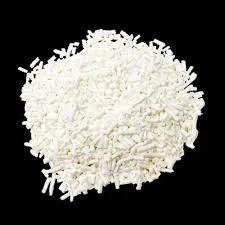
Potassium sorbate
Potassium sorbate
Potassium sorbate is the potassium salt of sorbic acid, chemical formula CH3CH=CH−CH=CH−CO2K. It is a white salt that is very soluble in water (58.2% at 20 °C). It is primarily used as a food preservative (E number 202).Potassium sorbate is effective in a variety of applications including food, wine, and personal-care products. While sorbic acid occurs naturally in rowan and hippophae berries, virtually all of the world's supply of sorbic acid, from which potassium sorbate is derived, is manufactured synthetically.
Production
Potassium sorbate is produced industrially by neutralizing sorbic acid with potassium hydroxide. The precursor sorbic acid is produced in a two-step process via the condensation of crotonaldehyde and ketene.
Uses
Potassium sorbate is used to inhibit molds and yeasts in many foods, such as cheese, wine, yogurt, dried meats, apple cider, dehydrated fruits, soft drinks and fruit drinks, and baked goods.[8] It can also be found in the ingredients list of many dried fruit products. In addition, herbal dietary supplement products generally contain potassium sorbate, which acts to prevent mold and microbes and to increase shelf life. It is used in quantities at which no adverse health effects are known, over short periods of time.[9] Labeling of this preservative on ingredient statements reads as "potassium sorbate" or "E202". Also, it is used in many personal-care products to inhibit the development of microorganisms for shelf stability. Some manufacturers are using this preservative as a replacement for parabens. Tube feeding of potassium sorbate reduces the gastric burden of pathogenic bacteria.
Potassium Sorbate
Also known as "wine stabilizer", potassium sorbate produces sorbic acid when added to wine. It serves two purposes. When active fermentation has ceased and the wine is racked for the final time after clearing, potassium sorbate renders any surviving yeast incapable of multiplying. Yeast living at that moment can continue fermenting any residual sugar into CO2 and alcohol, but when they die, no new yeast will be present to cause future fermentation. When a wine is sweetened before bottling, potassium sorbate is used to prevent refermentation when used in conjunction with potassium metabisulfite. It is primarily used with sweet wines, sparkling wines, and some hard ciders, but may be added to table wines, which exhibit difficulty in maintaining clarity after fining.
Some molds (notably some Trichoderma and Penicillium strains) and yeasts are able to detoxify sorbates by decarboxylation, producing piperylene (1,3-pentadiene). The pentadiene manifests as a typical odor of kerosene or petroleum.
Toxicology
In pure form, potassium sorbate is a skin, eye, and respiratory irritant.Concentrations up to 0.5% are not significant skin irritants.
As a food additive, potassium sorbate is used as a preservative in concentrations of 0.025–0.100%,which in a 100 g serving yields an intake of 25–100 mg. In the United States, no more than 0.1% is allowed in fruit butters, jellies, preserves, and related products.Up to 0.4% has been studied in low-salt, naturally-fermented pickles, and when combined with calcium chloride, 0.2% made "good quality pickles."Potassium sorbate has about 74% of sorbic acid's anti-microbial activity.When calculated as sorbic acid, 0.3% is allowed in "cold pack cheese food." The upper pH limit for effectiveness is 6.5.
The maximum acceptable daily intake for human consumption is 25 mg/kg, or 1750 mg daily for an average adult (70 kg).Under some conditions, particularly at high concentrations or when combined with nitrites, potassium sorbate has shown genotoxic activity in vitro.
Three studies conducted in the 1970s did not find it to have any carcinogenic effects in rats.
-
Pure Sodium Dichloroisocyanurate Dihydrate | Powerful DisinfectantNewsAug.29,2025
-
Industrial Chemicals: Quality & Purity for Every IndustryNewsAug.28,2025
-
Nitrile Rubber Honoring Strict Production StandardsNewsAug.22,2025
-
Aspartame Ingredients Honoring Food Safety ValuesNewsAug.22,2025
-
Fertilizer for Balanced Plant NutritionNewsAug.22,2025
-
Cyanide Gold Processing with High Purity AdditivesNewsAug.22,2025
-
Formic Acid in Textile Dyeing ApplicationsNewsAug.22,2025
Hebei Tenger Chemical Technology Co., Ltd. focuses on the chemical industry and is committed to the export service of chemical raw materials.
-

view more DiethanolisopropanolamineIn the ever-growing field of chemical solutions, diethanolisopropanolamine (DEIPA) stands out as a versatile and important compound. Due to its unique chemical structure and properties, DEIPA is of interest to various industries including construction, personal care, and agriculture. -

view more TriisopropanolamineTriisopropanolamine (TIPA) alkanol amine substance, is a kind of alcohol amine compound with amino and alcohol hydroxyl, and because of its molecules contains both amino and hydroxyl. -

view more Tetramethyl Thiuram DisulfideTetramethyl thiuram disulfide, also known as TMTD, is a white to light-yellow powder with a distinct sulfur-like odor. It is soluble in organic solvents such as benzene, acetone, and ethyl acetate, making it highly versatile for use in different formulations. TMTD is known for its excellent vulcanization acceleration properties, which makes it a key ingredient in the production of rubber products. Additionally, it acts as an effective fungicide and bactericide, making it valuable in agricultural applications. Its high purity and stability ensure consistent performance, making it a preferred choice for manufacturers across various industries.






